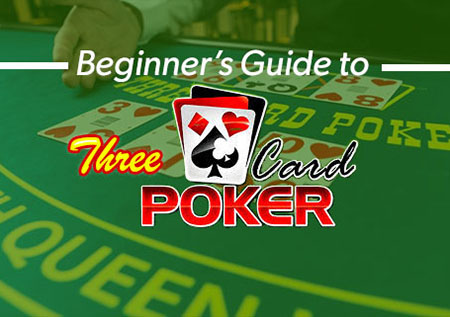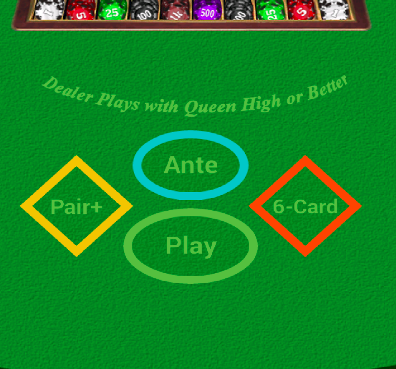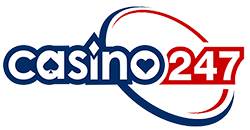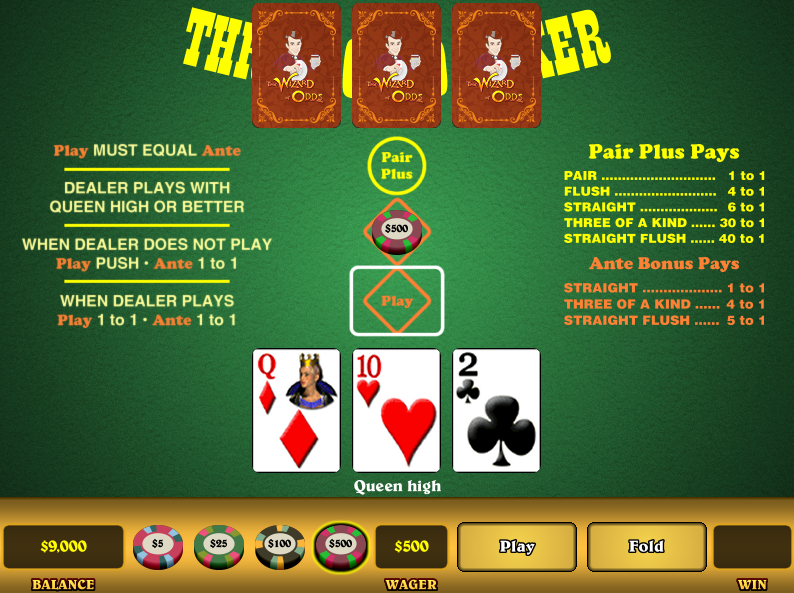HOW TO PLAY 3-CARD POKER
Like the skill-based advantages of good poker play mixed with the speed and thrill of a casino table game? 3-Card Poker might soon become your favorite casino game. The game is available to play at many online casinos. Below we delve into how to play 3-card poker to teach you the ropes. Have a read through to get to know the rules.
A popular choice in casinos from Vegas to London to Macau (and online, of course) 3-Card Poker was only invented in the mid-90s but has become such a staple of the casino world it’s hard to imagine a casino – live or online – without it. Even better, if you play proper 3-Card Poker strategy you can reduce the house edge to between 2-3%. With a payout percentage that high – and a very quick learning curve for how to play 3-Card Poker – you’ll see why it’s so popular very soon. Play for free until you get your feet wet then dive into one of the best casino games going!

Why Play 3-Card Poker online?
- The game is very easy to learn and play;
- You’ll be able to play the game using your online casino bonus;
- Using optimal strategy reduces the house edge to under 3%;
- Bets and payouts are very easy to make and understand;
- Very big payouts are given for hitting premium hands like straights, three of a kind and straight flushes
How to Play 3-Card Poker
Maybe the best thing about 3-Card Poker? It’s a very easy game to learn and play optimally. Hands are based on real poker hands but, as there are only three cards dealt with both the players and the dealer, they’ve been simplified to just six different hand types. If you’re familiar with the standard poker hand rankings this will come very easily to you but there is one small change to take note of: Because getting dealt a three-card straight is actually rarer than getting a flush in 3-Card Poker, a straight is a higher-ranked hand.
Here’s how hands are ranked in Three-Card Poker:
- Straight flush
- Three of a kind
- Straight
- Flush
- Pair
- High card
As it’s a three-card game you obviously can’t get quads (four of a kind) and there’s no “mini” version of a Full House, so those are the only hands you need to know to play 3-Card Poker.
How do I make bets in 3-card Poker?
They are two basic bets bettors can play in 3-Card Poker.
- Ante/Play
- Pair Plus
Both can be played simultaneously, in fact, and different amounts can be bet for each one as you see fit. The action starts with all players placing a bet in the “ante” betting circle. This is the main bet you are making against the dealer and his hand. You can then also choose to place a bet in the “pair plus” as well. This bet is independent of whatever outcome your hand has against the dealer.
This bet is simply saying you are hoping to be dealt a premium hand (a pair or better) and will be paid out according to a payout chart depending on how “premium” your hand is (see the payout chart below). Once all players at the table have made their ante bets (and their pair plus bet, if they so choose), the deal begins. Players and the dealer each get three cards, face down, from a standard 52-card deck. Watch the video below for a quick run-through of your basic bets and how to play standard 3-Card Poker:
Fold or Play in 3-Card Poker?
 After you’ve looked at your hand you can either fold – and forfeit your ante bet – or place another bet equal to the ante bet in the “Play” circle. This means that you’re continuing on against the dealer and will reveal your hand to see if you’ve beaten his or not and get paid accordingly. If the Dealer has a Queen high or better, his hand is in play. If the dealer does not have a qualifying hand, the payouts are:
After you’ve looked at your hand you can either fold – and forfeit your ante bet – or place another bet equal to the ante bet in the “Play” circle. This means that you’re continuing on against the dealer and will reveal your hand to see if you’ve beaten his or not and get paid accordingly. If the Dealer has a Queen high or better, his hand is in play. If the dealer does not have a qualifying hand, the payouts are:
Play bet: Push (your bet is returned to you)
Ante bet: 1 to 1
So if you didn’t fold your hand and the dealer has a non-qualifying hand (under Queen high) you’ll get your play bet back and win an equivalent ante bet.
If the dealer does have a qualifying hand and your hand beats it your bets pay:
- Play: 1 to 1
- Ante: 1 to 1
- Tie: Push
Many players like to play “blind” — meaning to play every hand regardless of their holdings. If you do that, however, you increase the house edge from around 3% to close to 7%. It’s decidedly better to stick to the Q64 rule which is to only play hands that have a Queen, 6 and 4 or higher. So our guide to 3-Card poker strategy below.
Ante Bonus & Pair Plus
An additional feature you get to take advantage of in 3-Card poker is the Ante Bonus, which is paid on the Ante wager for hands that rank as a straight or better. The Ante Bonus is paid out regardless of whether the dealer’s hand qualifies and regardless of whether the dealer or the player has the best hand. The typical Ante Bonus paytable pays 5 to 1 for a straight flush, 4 to 1 for a three of a kind and 1 to 1 for a straight (see chart below). As mentioned above the Pair Plus wager is an optional bet you can make before the hand begins. You can make it any amount you want based on the table minimum and maximum bets. This bet is also independent of whether your hand beats the dealer’s hand or not. If your dealt hand has a pair or better, you get paid out according to the table’s payout scale. See an example of a standard pair plus payout table below. Neither the Pair Plus or Ante bonus is contingent on beating the dealer’s hand so if you hit qualifying hands with either bet you’ll still get paid.
|
Hand Rankings |
Full Pay |
Full Pay |
|
Mini-Royal |
– |
– |
|
Straight Flush |
40 to 1 |
5 to 1 |
|
Three of a Kind |
30 to 1 |
4 to 1 |
|
Straight |
6 to 1 |
1 to 1 |
|
Flush |
4 to 1 |
– |
|
Pair |
1 to 1 |
– |
|
High Card |
– |
– |
The main catch with the Pair Plus bet is that it basically doubles the House edge up to about 6-7%. You will more than likely lose money making this bet long term but if you do hit a big hand like a straight flush the payout will be substantial.
3-Card Poker 6 card bonus
In some online casinos and land-based ones, you’ll also find an optional side bet you can make called the “6 Card Bonus.” This bet is paid out based on the combination of your 3-card poker hand with the dealer’s three-card hand. You combine the two three-card hands to make the best standard 5-card poker hand. You then get paid out according to a paytable like the following
| Poker Hand | Pay Table 1 |
| Royal Flush | 1,000 to 1 |
| Straight Flush | 200 to 1 |
| Four of a Kind | 100 to 1 |
| Full House | 20 to 1 |
| Flush | 15 to 1 |
| Straight | 9 to 1 |
| Three of a Kind | 8 to 1 |
While it looks enticing, the 6-Card Bonus is generally a bad bet. Even with the best payout table, the house advantage is in the 6-7% range and, based on your probability of hitting one of the payable hands, a pretty sure bet the casino will take your money in the long run. If you do hit on one of the bonus hands, though, your bet is paid out whether you win either of your ante/play bets.
How to play optimal 3-Card Poker Strategy
Watch the video below for our simple 3-Card Poker strategy guide:
The optimal strategy in 3-Card Poker is pretty simple. If you have a hand that’s at least Q/6/4 (ie a queen, 6, and 4 all in the same hand) or greater, you should play it. If you have less than that, you should fold. That’s pretty much it. If you stick to this very simple playing pattern you’ll reduce the house edge (depending on the table and payout percentages) to 2-3%. That’s the best you can do. Betting both the ante and the pair plus equally each time you bet also provides the best statistical chance of maximum return when playing over long periods of time.
Odds of Hitting a Pair Plus
- Pair 16.94%
- Flush 4.9%
- Straight 3.26%
- Three of a kind .24%
- Straight Flush .22%
If you add them all up, the average odds of hitting a pair plus in a hand is about 25% or 1 in 4. You’ll get a “high card” hand 75% of the time.
What that means is:
- Your best chance of making money (or losing the least) is to only play the Ante bets and
- Only play the “Play” bet on top of that if you have Q64 or higher.
To keep the house odds low you should never play the Pair Plus or 6-Card Bonus bet. You simply won’t hit enough premium hands or bonuses to make up for your losses.

